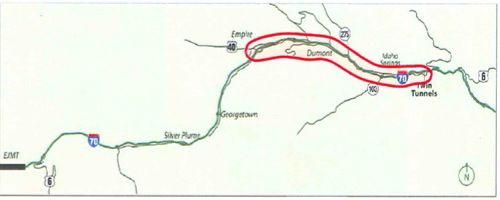 After a big weekend on the slopes of Copper Mountain, skiers and snowboarders returning to Denver sometimes face another challenge — the traffic gauntlet of I-70. But the Colorado Department of Transportation is on its way to completing several highway projects that should help make the trek a bit easier.
After a big weekend on the slopes of Copper Mountain, skiers and snowboarders returning to Denver sometimes face another challenge — the traffic gauntlet of I-70. But the Colorado Department of Transportation is on its way to completing several highway projects that should help make the trek a bit easier.
As soon as the traffic engineers finish up the Twin Tunnels project near Idaho Springs, they'll move on to adding a third eastbound lane from Empire Junction all the way to Floyd Hill. Empire Junction is where U.S. Highway 40 pours into I-70, with traffic from Winter Park adding to the already crowded conditions on Colorado's main east-west highway.
The nine-mile section of peak-period shoulder lanes should ould loosen up Sunday afternoon traffic jams, said CDOT mountain corridor manager Jim Bemelen.
The estimated cost for improving the shoulders is about $30 million, and funding for the project has been approved as part of a statewide $560 million slate of upgrades under the Responsible Acceleration of Maintenance and Partnerships (RAMP) program, announced by Gov. John Hickenlooper and CDOT director Don Hunt this week.
“It’s a third of the cost of the Twin Tunnels project or less and will bring a bigger benefit,” Bemelen said. The goal is to finish the project by the summer of 2015, with construction starting in the summer 2014.
The new eastbound lane will only be used for general traffic during peak travel times — and it will be a toll lane, Bemelen said, adding that the price for the toll lane hasn’t been finalized yet.
Once the new lane is in operation the price could change. If CDOT sees that the lane isn’t being used enough, the price might me lowered, and vice-versa, if it ends up being as busy as the existing lanes, the price could be raised, he explained.
Similar traffic management techniques have been used with success in other states, and in some areas, I-70′s eastbound shoulder is already wide enough to carry the load. But in general, CDOT will add two to three feet of width in many areas along that section, especially around interchanges to ensure adequate room for acceleration lanes, he said.
“On some places, that will push us over the edge (of the existing embankments), so we’ll have to build some walls,” he said. The project will also require a new bridge at State Highway 103.
Bemelen said CDOT hopes to soon launch an interactive website for the project, including video presentations and a public comment function.
Filed in Colorado News | Copper Mountain News |